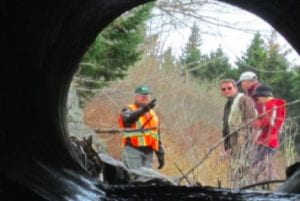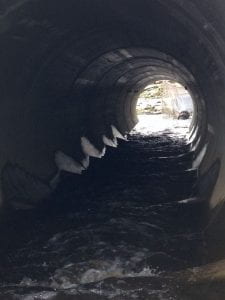There are several reasons why we lost our run. When people netted the alewives during the 1980’s, they were harvesting adult fish that were trying to reach the marsh in order to spawn. Not really knowing that fish couldn’t reach the marsh to spawn, fish were being taken from the population, while the population wasn’t able to reproduce itself.
This was because fish couldn’t get through a culvert put there during the 1970’s. A metal culvert under Rt 131 was put in during the 1970’s and was put in too high. From this time on, the fish had a hard time to pass through the culvert under the road, and continue into the marsh. However, In August of 2015, that metal culvert was replaced with the cement culvert with weir sections. It was placed lower in elevation, and the weirs create little pools of water inside the culvert to help the fish (and also elvers and any smelt) swim up through the culvert. This allowed fish to pass under Rt. 131 like they used to.
Another positive community action was that each spring, from 2009-2014, the state stocked the marsh with adult alewives harvested from a healthy run elsewhere in the state. These adults spawned in the marsh, and then went back out to sea. The eggs that hatched in the marsh spent the summer there and then went offshore for their first winter, then out to the Gulf of Maine to grow to adulthood. When they became a three or four-year old fish, those surviving fish made their way back to Ripley Creek because they imprinted on our marsh waters where they had hatched!
We should have more returning fish. We should have hundreds returning to the marsh. This will be the fourth spring since the new culvert was put in and fish could reach the marsh, so perhaps this is a year we might see more returning fish. However, we can also wonder if the salt coming into the marsh on spring tides is decreasing the numbers of alewives that hatch from eggs, or survive as fry. We know that these spring tides didn’t happen regularly back in the 1980’s, as they do today.




